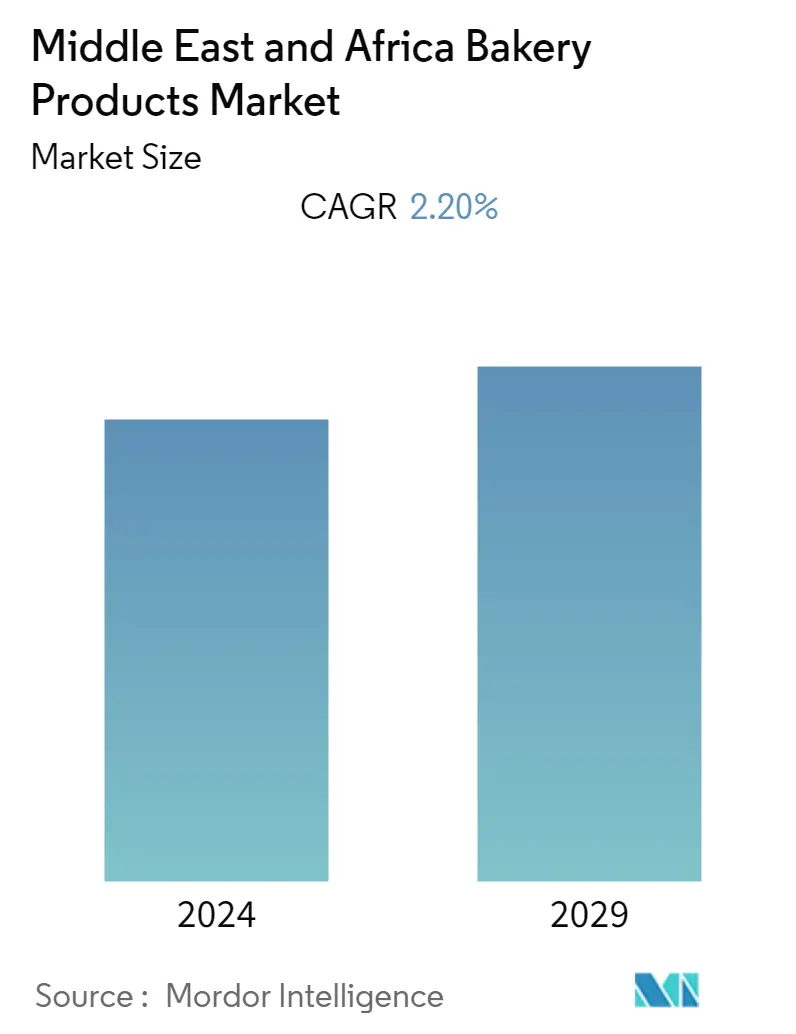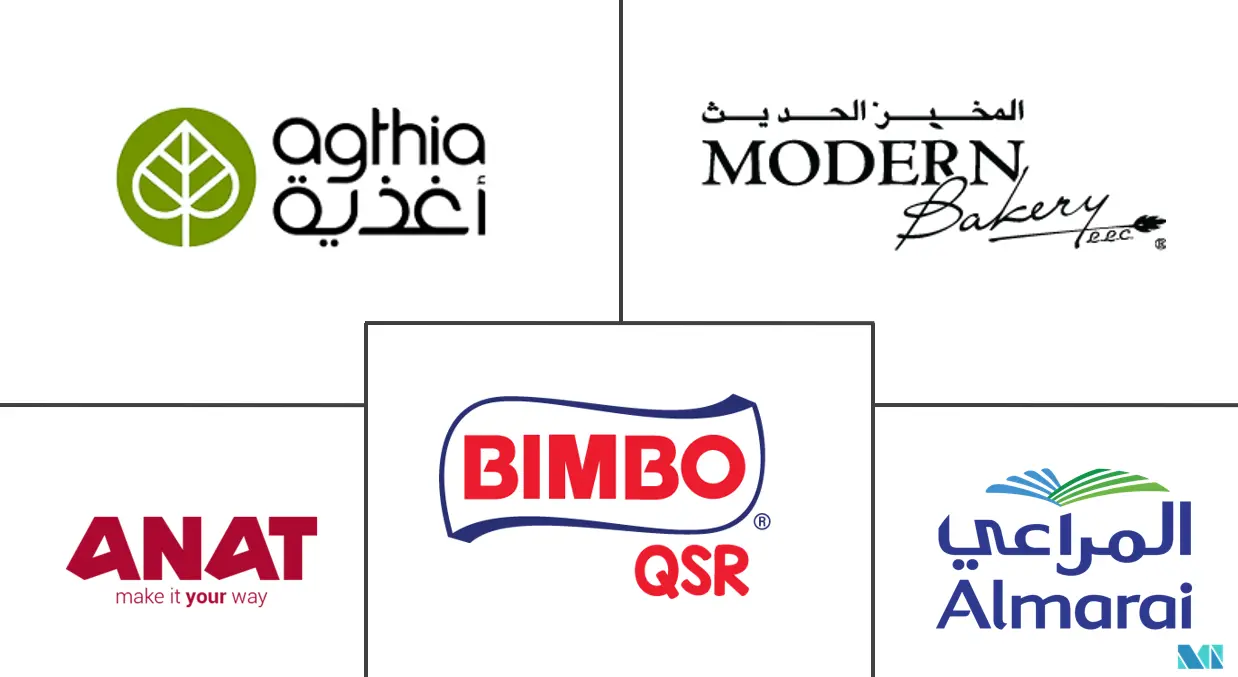Market Size of Middle East and Africa Bakery Products Industry

| Study Period | 2019 - 2029 |
| Base Year For Estimation | 2023 |
| Forecast Data Period | 2024 - 2029 |
| Historical Data Period | 2019 - 2022 |
| CAGR | 2.20 % |
| Market Concentration | Low |
Major Players
*Disclaimer: Major Players sorted in no particular order |
Middle East and Africa Bakery Product Market Analysis
The Middle-East and Africa bakery product market is expected to register a CAGR of 2.2% over the forecast period.
- The market is primarily driven by convenience, accessibility, and nutrition profile. Moreover, due to urbanization, the increasing working population, the growth of out-of-home consumption, and increased demand for instant and nutritious products, the sales of bakery products increased in recent times. Convenience and nutrition being the priority, consumers are looking for ready-to-eat bakery products with the incorporation of nuts and fruit pieces to maintain the balance in the nutrition profile of the product.
- Additionally, premium bakery places and artisanal baking has gained importance in the region for their unique taste and exclusivity of the product. Consumers in the market often prefer personalized pastry and other artisanal baking products over conventional products.
- Bread consumption in Africa is expected to be majorly in the form of packaged products in the coming years. Corn, sorghum, and starchy plant roots are mainly preferred in Sub-Saharan Africa, particularly in rural regions. Thus, bread consumption is expected to grow slightly during the forecast period. Although the demand for healthier snacking options is increasing, sweet baked goods remain popular and the preferred item in African markets.
- Most bakery product launches in African countries belong to sweet segments, strongly led by biscuits and cookies. Biscuits and cookies were among the commonly consumed products in the market for their ease of availability and affordable price. Additionally, these products are retailed on a unit basis which encourages consumers in the region to opt for single units or small quantities; these factors tend to drive the market in a positive direction in the coming years.
Middle East and Africa Bakery Product Industry Segmentation
Bakery products are prepared from flour or meal derived from some form of grains and are available in a wide range.The Middle East and African bakery products market is segmented by product type, distribution channel, and country. Based on product type, the market is segmented into cakes and pastries, biscuits and cookies, bread, morning goods, and other product types. Based on the distribution channel, the market is segmented into hypermarkets/supermarkets, convenience stores, specialty stores, online retailing, and other distribution channels. Also, the study analyzes the bakery products market in emerging and established markets across the Middle East and Africa, including South Africa, Saudi Arabia, and the Rest of the Middle East and Africa. For each segment, the market sizing and forecasts have been done based on value (in USD Million).
| Product Type | |
| Cakes and Pastries | |
| Biscuits and Cookies | |
| Bread | |
| Morning Goods | |
| Other Product Types |
| Distribution Channel | |
| Supermarkets/Hypermarkets | |
| Convenience Stores | |
| Specialist Stores | |
| Online Retailers | |
| Other Distribution Channels |
| Geography | |
| South Africa | |
| Saudi Arabia | |
| Rest of Middle-East and Africa |
Middle East and Africa Bakery Products Market Size Summary
The Middle East and Africa bakery product market is experiencing growth driven by factors such as urbanization, an increasing working population, and a rise in out-of-home consumption. Consumers are prioritizing convenience and nutrition, leading to a demand for ready-to-eat bakery products that incorporate nuts and fruit pieces. The region has seen a growing interest in premium and artisanal baking, with consumers favoring personalized and exclusive products over conventional options. In Africa, bread consumption is expected to increase, particularly in packaged forms, while sweet baked goods like biscuits and cookies remain popular due to their affordability and ease of availability. Specialty food stores, including artisanal and home-based bakeries, are expanding the reach of bakery products, supported by the growth of supermarkets and hypermarkets offering a diverse range of products.
In South Africa, the bakery products market is expanding due to changing consumer lifestyles and a rising demand for healthier options like multi-grain and whole wheat bread. The market is characterized by a willingness to pay premium prices for products with low glycemic indices and high fiber content. Domestic biscuit brands are seeing increased sales, driven by affordability and price competitiveness. Health and wellness trends are influencing consumer preferences, with a growing demand for clean label products. The market is fragmented, with major players like Bimbo QSR, Puratos Group, and Modern Bakery LLC engaging in strategic activities such as mergers and expansions to enhance their market presence. Recent developments include the expansion of artisanal bakeries and the introduction of new bakery products in the region, reflecting ongoing innovation and consumer engagement.
Middle East and Africa Bakery Products Market Size - Table of Contents
-
1. MARKET DYNAMICS
-
1.1 Market Drivers
-
1.2 Market Restraints
-
1.3 Porter's Five Forces Analysis
-
1.3.1 Threat of New Entrants
-
1.3.2 Bargaining Power of Buyers/Consumers
-
1.3.3 Bargaining Power of Suppliers
-
1.3.4 Threat of Substitute Products
-
1.3.5 Intensity of Competitive Rivalry
-
-
-
2. MARKET SEGMENTATION
-
2.1 Product Type
-
2.1.1 Cakes and Pastries
-
2.1.2 Biscuits and Cookies
-
2.1.3 Bread
-
2.1.4 Morning Goods
-
2.1.5 Other Product Types
-
-
2.2 Distribution Channel
-
2.2.1 Supermarkets/Hypermarkets
-
2.2.2 Convenience Stores
-
2.2.3 Specialist Stores
-
2.2.4 Online Retailers
-
2.2.5 Other Distribution Channels
-
-
2.3 Geography
-
2.3.1 South Africa
-
2.3.2 Saudi Arabia
-
2.3.3 Rest of Middle-East and Africa
-
-
Middle East and Africa Bakery Products Market Size FAQs
What is the current Middle East and Africa Bakery Products Market size?
The Middle East and Africa Bakery Products Market is projected to register a CAGR of 2.20% during the forecast period (2024-2029)
Who are the key players in Middle East and Africa Bakery Products Market?
Bimbo QSR, Modern Bakery LLC, Agthia, Anat Foods and Almarai Group are the major companies operating in the Middle East and Africa Bakery Products Market.

